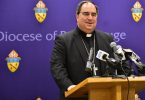
by Mark Pattison
WASHINGTON (CNS) — In May, Discovery Communications swung a deal with AT&T to take its WarnerMedia assets off its hands for a cool $43 billion. Other than maybe the lawyers who made this swap possible, the jury is out on who will materially benefit from this huge asset transfer.
But it’s no mystery who can benefit from another communications-related development that also has happened this May and is costing a lot less: The Federal Communications Commission established the Emergency Connectivity Fund Program, which will help schoolchildren with their virtual learning needs.
Coming in at $7.17 billion — not even 17% of the Discovery-AT&T price tag for Warner — it has the potential to materially help millions of children directly, and their families indirectly.
The fund will allow schools — including Catholic and other nonpublic schools that are eligible — to apply for grants from the FCC to buy tablets, laptops or other devices for their students to use, or to outfit devices with “hot spots” giving children consistent internet access to get their homework done.
Schools can’t use this money to improve internet access for their own buildings. But there was money in the CARES Act passed last year to permit them to do just that. Moreover, on May 3 — exactly one week before the Emergency Connectivity Fund Program was announced — the FCC detailed how Americans can apply for the Emergency Broadband Benefit that allows qualifying households to get $50 subtracted from their monthly internet bill.
There had been a homework gap cited in the previous decade, but with the onset of the coronavirus pandemic and the wholesale switchover to virtual learning, that gap became a yawning chasm.
“One study estimates that last spring, more than 15 million public school students did not have home access to either an internet connection or a device adequate for distance learning, and approximately 9 million of those students lived in households with neither an adequate connection nor an adequate device for distance learning,” the FCC said in its report authorizing the new program.
Mind you, that’s just students in public schools.
“Certainly it’s a huge opportunity for schools to be able to provide for those students and teachers who don’t have effective equipment at home to be able to engage in learning virtually and for the student for the ability to do their homework effectively — even if they go back to school permanently — for many of the students they may be two or three kids trying to share a computer at home,” said Sister Dale McDonald, a Presentation of the Blessed Virgin Mary Sister who is director of public policy for the National Catholic Educational Association.
The NCEA does not have a formal count of how many Catholic schools, or how many students in those schools, have broadband deficiencies. “But what we do know anecdotally in a lot of our inner-city schools where there are a lot of students on financial aid that two or three kids will have to share one tablet or even an old computer” to get homework done, Sister McDonald said.
What this new FCC program will help pay for is at-home connections, she added — regardless of what or where is called “home.”
“For instance, for children who may be homeless and living in shelters, what the school would do would be to give them a hot spot that they could use for wherever they are. The shelter can’t apply, but if the student has the hot spot, they would be able to do the work” in the shelter, Sister McDonald said. “If they were living in a car and they had a hot spot, they could do the homework in the back seat.”
The student may not even have to be at home to benefit from a consistent internet connection.
Although school buildings can’t be outfitted with hot spots, school buses can. “What they could do with this new program is (pay for) wiring up the school buses,” Sister McDonald said, “so that students who have like an hour bus trip or a 45-minut bus trip could get their homework started on the bus.”
Right now, the biggest catch is that no school — public, private or Catholic — can apply for the money because the application window has not yet opened. The FCC anticipates being able to open that window in the next 30-60 days. Once open, it will be open for all schools for 45 days.
As a result, students who badly need internet access will probably not have it when the next school year begins. But once they’ve got a hot spot or a better device, be it laptop or tablet, there should be no stopping them.






